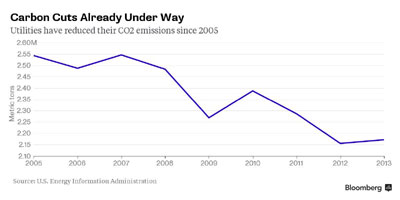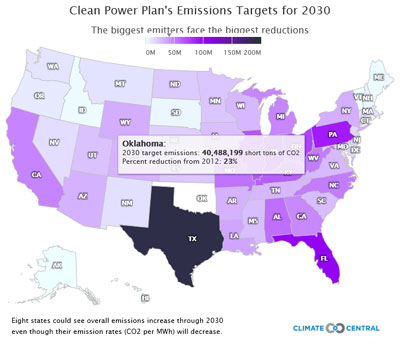The EPA formally published the Clean Power Plan in the Federal Register, triggering an all-out war that will likely end up in the Supreme court.
The regulations are the centerpiece of the US Climate Pledge – without them, we can’t meet our promise to bring down emissions 26-28% by 2030. They were put in place in the absence of Congressional legislation on climate.
In the US, coal-fired power plants are top source of carbon emissions, followed by emissions from cars and trucks. This is why the Obama administration has prioritized lowering power plant emissions and fuel economy standards for vehicles.
While President Obama calls it "the biggest, most important step we’ve ever taken to combat climate change," 25 coal-heavy states and Murray Energy immediately filed a lawsuits, asking for the rules to be overturned.
Led by West Virginia, the states are: Alabama, Arizona, Arkansas, Colorado, Georgia, Florida, Indiana, Kansas, Kentucky, Louisiana, Michigan, Missouri, Montana, Nebraska, New Jersey, North Carolina, Ohio, South Carolina, South Dakota, Texas, Utah, Wisconsin and Wyoming.
Led by New York, 13 states plus the District of Columbia and New York City will intervene in the case to "fully defend the rules." The states are: California, Connecticut, Delaware, Maine, Maryland, Massachusetts, New Mexico, Iowa, New Hampshire, Oregon, Rhode Island, Vermont and Washington. Attorneys from Earthjustice, Natural Resource Defense Council, Sierra Club and Environmental Defense Fund will also intervene.
On the corporate side, the US Chamber of Commerce, National Association of Manufacturers are among the 14 business groups that filed a court challenge.
The court has already rejected plaintiffs’ call to put the regulations on hold now. Plaintiffs wanted to use it as a signal to the world at next month’s UN Climate Summit that Obama’s climate pledge is on shaky ground. Because of the court’s calendar, putting the rules on hold will be considered in late December.
In Congress, Senate Majority Leader Mitch McConnell (R-KY) and Senator Joe Manchin (D-WVA) are attempting to repeal the regulations through legislation.
The public can comment on the plan through the end of this year.
Obama says:
"We only get one home. We only get one planet. There is no plan B" … "We’re the first generation to feel the effects of climate change and the last generation that can do something about it. This is the moment to get this right" … There is such a thing as being too late when it comes to climate change.
"There will be critics of what we’re trying to do. There are cynics who will say it cannot be done. We’ve heard the same stale arguments before … "scare-mongering tactics" and "excuses for inaction."
Failing to fight climate change would be "shameful", he says, urging Americans to be skeptical of the criticism they will hear. "Long before the details of this Clean Power Plan were even decided, special interests and their allies in Congress were already mobilizing to oppose it with everything they’ve got."
What’s in the Final Version of the Clean Power Plan
From our point of view, the final version is a big improvement from the original power plant rules proposed about a year ago.
1. More ambitious targets to cut carbon emissions from power plants: 32% by 2030 from 2005 levels, up from 30% – a 9% increase.
2. Renewable energy is front and center, rather than natural gas or nuclear. It increases the goal for renewable energy in the US to 28% by 2030, up from 22% in the original plan. That’s because the industry is growing faster than earlier projections, explains Gina McCarthy, EPA Administrator. Neither natural gas or nuclear can be used to meet state emissions targets.
3. Under the Clean Energy Incentive Program, states that expand renewable energy quickly – breaking ground on projects before the compliance period begins in 2020-2022 – earn credits that can offset pollution emitted after that. Energy efficiency projects in low income communities get double the credits than in the original rules.
States can award credits to units like a coal-fired power plant, which can use them to comply with emission standards. And states that produce more renewable energy than required by the plan can sell their surplus to laggard states.
4. Every state has customized emission-reduction targets based on its current energy mix. Each state develops its own plan to meet the targets, but if it doesn’t, a federally designed program that includes cap-and-trade goes into effect.
States can choose from a mix of options: improve energy efficiency; add renewables; work with other states in a regional cap-and-trade program; and even make dirty, outmoded coal plants more efficient. They don’t have to shut coal plants down. New coal plants can’t be built, however, unless they capture carbon emissions.
States can even charge a carbon tax as a "fee" to bring down emissions. But since taxes can’t guarantee emission cuts, a "backstop" is required to ensure "federally enforceable emission standards" are met.
Go to Climate Central to see the targets for each state:

5. States have an extra two years to submit plans and begin complying – until 2022. The downside is this postpones action.
Research shows the average person’s electric bill will be $85 a year less by 2030 and premature deaths from pollution will decline by an impressive 88%. The plan is expected to cost $8.4 billion, while providing up to $93 billion in climate, health and environmental benefits by 2030.
Remember – this is the First Time there are any federal limits on carbon emissions from power plants – which are responsible for a full 40% of US emissions.
Obama says: "Think about that. We limit the amount of toxic chemicals like mercury and sulfur and arsenic in our air and water, and we’re better off for it. But power plants can still dump unlimited amounts of harmful carbon pollution into the air we breathe. For the sake of our kids, for the health and safety of all Americans, that’s about to change."
Both Sides Ready For Huge Fight
ALEC will help states fight power plant regulations with its usual model legislation, Act Requiring Approval of State Plan to Implement EPA’s Carbon Guidelines. It directs state attorney generals to join lawsuits against the EPA to prevent "unlawful and costly obligations from being imposed on states," and calls for transferring money into a special fund set up by participating states to underwrite efforts to challenge unwanted environmental regulations. The money would come from state appropriations and "gifts, grants and donations" from outside groups (ie, fossil fuels). It also gives state governments special authority to "expedite approval of resources to challenge the EPA’s Clean Power Plan."
In June, the House passed a bill along party lines that allows states to opt out of power plant regulations. Another attack is through appropriations, where besides cutting EPA’s budget another 9% – by $718 million – it would be barred from funding the Clean Power Plan (sponsor: Senator Mitch McConnell (R-KY).
Meanwhile in reality world, 31 states are more than halfway toward meeting EPA’s 2020 goals for cutting carbon emissions and the plan will create about 360,000 jobs by 2020.
The coal industry is the biggest loser, but utilities aren’t – they are also well on their way to significantly lowering emissions.

"When we set ground rules to limit carbon pollution, we send a long-term market signal that propels innovation and investment in clean energy technologies, expanding new industries and creating good-paying jobs," says EPA Administrator Gina McCarthy.
Polls show that 75% of Americans now accept the scientific consensus on climate change, even 59% of Republicans – up from 47% six months ago.
Learn more at the White House website:
